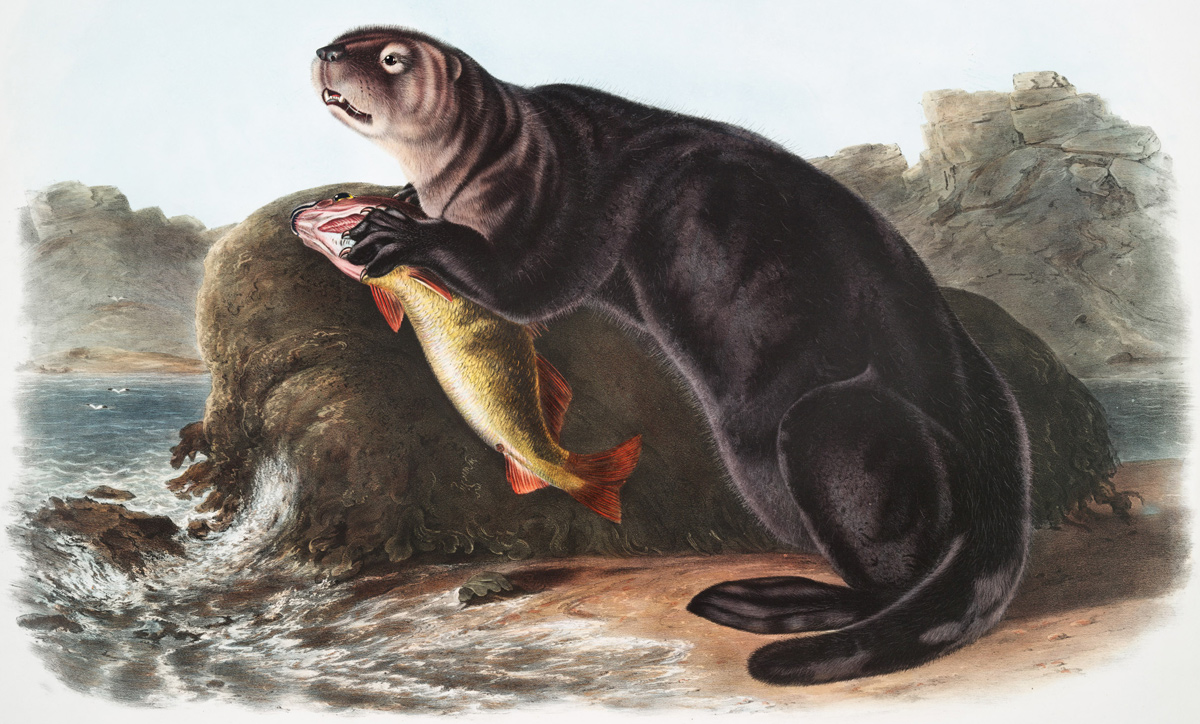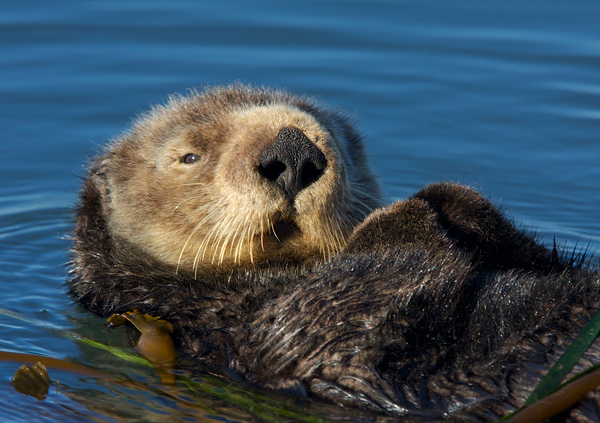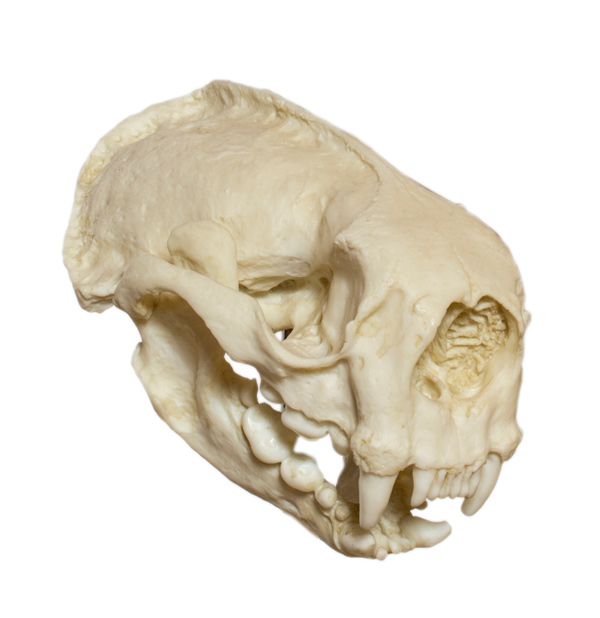Enhydra Marina, Erxleben
by John W. Audubon
Plate CXXXVI, The Quadrupeds of North America, provided by www.flickr.com/photos/153584064@N07/27104669867/. Permission to use granted under the Creative Commons Attribution-Share Alike 4.0 International license.
During their short dives, sea otters typically forage for shellfish and clams. To open some shells, they use rocks—a rare use of tools among mammal species. They are the only marine mammal to catch fish with forepaws instead of teeth. In the above illustration, the artist saw only one see otter. It was diving from a log in pursuit of fish in the San Joaquin River. Had the hapless creature—who was shot at several times—succeeded as shown above, it would have likely remained in the water to eat its catch.[1]“John James Audubon, John Bachman, and John Woodhouse Audubon, The Quadrupeds of North America (New York: V. G. Audubon, 1854), 3:173–74, available at … Continue reading
The following is an extract from We Proceeded On, the quarterly journal of the Lewis and Clark Trail Heritage Foundation[2]Cameron La Follette and Douglas Deur, “Sea Otters, Empire, and the Struggle for the Northwest Coast”, We Proceeded On, May 2021, Volume 47, No. 2. The original article is provided at … Continue reading.
The Sea Otter Trade
Sea otters are social creatures, known for drifting on the ocean swell in groups called rafts as well as for carrying their young on their bellies. They have no insulating blubber, such as whales and other marine mammals do. To keep warm, sea otters rely instead on a high metabolism and their renowned thick, luxurious fur. They must eat nearly a third of their body weight each day. The sea otter diet generally consists of energy-rich shellfish, and they are especially fond of sea urchins, which graze on the kelp and other marine algae that form the basis of nearshore ecosystems. Thus, sea otters are crucial to maintaining the health of the rich marine environments of the Pacific coast.
By the time of Lewis and Clark’s sojourn at the mouth of the Columbia River in the winter of 1805–1806, sea otter hunts and trading ventures had been at white heat for twenty years—the key hunters being conscripted Aleut and Kodiak individuals working for Russian interests to the north and, closer to home, Native peoples who hunted otters and traded the pelts for foreign goods brought by the trading ships. The first British ship to arrive in Cook’s wake was the Sea Otter, captained by James Hanna, which came to Nootka Sound on Vancouver Island in 1785, and left with some 560 furs for Canton. By the following year seven British vessels cruised the Northwest coast for sea otter trading opportunities, and the maritime fur trade was well and truly begun.[3]James R. Gibson, Otter Skins, Boston Ships, and China Goods: The Maritime Fur Trade of the Northwest Coast, 1785-1841 (Montreal: McGill-Queen’s University Press, 1992), 23. In rapid succession, the ships of many nations—Spain, France, Russia, the United States—all plied these waters in search of wealth from sea otter furs.
For the Clatsop, Chinook, Tillamook, and other peoples living near the Columbia River’s mouth, the sea otter was a species of key cultural value. Ancient oral traditions described the exploits of sea otter hunters in distant times of young Nehalem Tillamook women hunting sea otters at Tillamook Head, of young Chinook men trading for sea otter pelts before obtaining powers and great wealth.[4]See Charles Cultee’s accounts in Franz Boas, Chinook Texts, Bulletin no. 20 (Washington D.C.: U.S. Bureau of American Ethnology, 1894), 220–2, and Clara Pearson’s account in Elizabeth … Continue reading The oral traditions speak of prosperity related to the hunting of otter, small fortunes made from the pelts and robes, and other items crafted from its fur giving some hint of the fur trade wealth yet to come.
Journal Descriptions
Sea Otter
Enhydra lutris
Photo by Gregory Smith. Permission to use granted under the Creative Commons Attribution-ShareAlike 2.0 Generic (CC-BY-SA 2.0) license.
The journals of the Lewis and Clark Expedition make it clear that its members guessed at the extent of the burgeoning maritime fur trade, and tried to gauge it, as well as, in a minor way, participate in it. There are more than thirty direct references to sea otters in the journals (often commented on by several expedition members), such as William Clark‘s statement of 1 November 1805, that while on the Columbia’s “Grand Shutes,” quite a ways upriver from the coast, he saw “Great numbers of Sea Otters, they are So cautious that with dificuelty got a Shot at one to day . . .”[5]Gary E. Moulton, ed., The Definitive Journals of the Lewis and Clark Expedition, 13 vols. (Lincoln: University of Nebraska Press, 1983-2001), 5:369.
The journals record some confusion as to the range of the sea otter. Joseph Whitehouse wrote 23 Nov 1805, some three weeks later:
The Sea Otter is plenty, between this and the great falls of the Columbia River; but are very difficult to be got. They are rarely to be caught in traps, & when shot they sink immediately, which makes the procuring of them so difficult.[6]Moulton, ed., Journals, 11:397.
But Meriwether Lewis recorded 23 February 1806:
when we first saw those animals at the great falls and untill our arrival at this place we conseived they were the Sea Otter. but the indians here have undeceived us.[7]Moulton, ed., Journals, 6:340.
Were there sea otters ranging far up the Columbia from the coast? It is uncertain. Some early explorers described spotting sea otters upriver, but other later observers did not. Scholars such as Marguerite Forest have argued that sea otter behavior changed dramatically under the intense hunting pressures of the maritime fur trade, with otters spending much less time on land and in fresh water.[8]Marguerite S.E. Forest, “Searching for Sea Otters,” We Proceeded On 33:3 (August 2007):21–2, lewisandclark.org/wpo/pdf/vol33no3.pdf#page=19.
The journals also evince many efforts by expedition members to trade with the Native residents of the coast for the coveted sea otter pelts and, occasionally, Native willingness to sell.[9]Moulton, ed., Journals, 6:325 (Meriwether Lewis, 18 February 1806). Native peoples preferred blue beads, and were often unwilling to sell their treasured pelts for any other item. Ship-borne trade had raised expectations, so that blue beads and other trade goods from metal tools to porcelain plates were already making their way into many Native households in exchange for these pelts, well before the arrival of Lewis and Clark. In spite of the “emence quantity of . . . Sea otter”[10]Moulton, ed., Journals, 6:11 (William Clark, 3 November 1805). Lewis and Clark found:
Such high prices we were uneabled to purchase, with[out] reduceing our Small Stock of merchindize on which we have to depend in part for a Subsistance on our return home.[11]Moulton, ed., Journals, 6:81 (William Clark, 23 November 1805).
Extirpation of Oregon’s Sea Otters
Sea Otter Skull (replica)
Courtesy Matteo De Stefano/MUSE. Permission to use granted under the Creative Commons Attribution-ShareAlike 3.0 Unported license.
The sea otter is well-adapted to marine environments. Not only can it close its nostrils and ears when diving, its unusually dense bones make it easier to sink.
Studies of pre-contact Native middens on the coast demonstrate that the sea otter inhabited not only the coast in the immediate vicinity of Fort Clatsop, but the entire Pacific coastline of what is now Oregon.15 The single-minded hunting of sea otters was entirely successful, resulting in complete extirpation of the sea otter on Oregon’s coast by the early twentieth century.
Early maritime fur trading accounts touching on the sea otter population of Oregon usually record ships, beginning with Robert Gray‘s Columbia Rediviva in 1792, that entered over the notorious Columbia River Bar for sea otter trading opportunities.[12]Two books tallying ships and ship voyages during the maritime fur trade on the Northwest coast, one enumerating British and American ships, the other American ships only, both reflect this focus of … Continue reading Captain George Vancouver‘s voyage along the southern Oregon coast in April 1792 produced one of the few accounts to mention lesser-known regions. He noted in his journal for 24 April that the Native peoples of the Cape Blanco area (now in Curry County) were dressed in garments “made principally of the skins of deer, bear, fox, and river otter; one or two cub skins of the sea otter, were also observed among them.”[13]T.C. Elliott, “Oregon Coast as Seen by Vancouver in 1792,” Oregon Historical Quarterly, 30:1 (March 1929): 37.
Sea otters continued to be mentioned in the records of the lower Columbia fur trade posts, Fort Astoria and Fort Vancouver, where local chiefs served as middlemen charging 100 to 500 percent markups on pelts entering the Columbia region from other tribes along the coast, and building short-lived international trade empires of their own.
One Chinookan chief in particular, Chief Concomly, began to centralize his power and expand his dominion especially with the construction of John Jacob Astor‘s fur-trading fort at Astoria in 1811. When the principal fur trading post moved from Fort Astoria to Fort Vancouver in 1824, in part because of declining sea otter abundance, Concomly showed he was irreplaceable to the fur trade. Father Pierre-Jean De Smet, visiting Fort Vancouver more than a decade after Concomly’s death in 1830, was regaled with tales of Concomly’s asserting his fur wealth to the new Hudson’s Bay Company managers:
When he used to come to Vancouver in the days of his glory, 300 slaves would precede him, and he used to carpet the ground that he had to traverse, from the main entrance of the fort to the governor’s door, several hundred feet, with beaver and otter skins.19
This frenetic interethnic trade exhausted the north coast fur animals in only a few years, at the same time that epidemic disease swept away Concomly and many of his people.
Newspapers in the first decade or so of the twentieth century found it noteworthy to record the killing or death of even a single sea otter, such as one killed off Cape Blanco on the south coast during a severe southwester in 1908.[14]Oregon Journal, 4 February 1908, 6. “No hunter’s trophy equals a sea otter,” crowed another story about the same prize.[15]Coos Bay Times, February 6, 1908, 4. A very late mention of sea otters, again on the south coast, records the killing of a single one in July 1910.[16]“Got Sea Otter,” Coos Bay Times, Evening Edition, 26 July 1910, 3. But even in the face of the obvious, a 1913 story of a sea otter sighting at Willapa Bay, Washington, just north of the Columbia River estuary, celebrated the potential for a renewed hunt: “Their return means the reopening of the business of otter hunting, which made fortunes for many a fisherman years ago.”[17]Julie Tennis, “Sea otters in Ilwaco, first time in nearly a century,” Chinook Observer, Long Beach, Wa., 16 March 2009. However, by that time, if not years before, the sea otter was extinct on the Oregon coast, except for occasional strays, and has remained absent to the present day.
Restoring the Sea Otter to Oregon
Attempts to restore sea otters to Oregon and Washington (where they had also been extirpated) came via transfers of otters from Amchitka Island, in the Aleutian chain of Alaska. The U.S. Fish and Wildlife Service coordinated the transfers, made necessary because the Atomic Energy Commission proposed, and successfully detonated, the five-megaton Cannikin nuclear device in a subterranean test on 6 November 1971. It was the largest U.S. underground detonation to date. Ironically, Amchitka had been a nature reserve, part of the U.S. National Wildlife Refuge system, designated as such by President William Howard Taft in 1913.[18]D. J. Kinney, “The otters of Amchitka: Alaskan nuclear testing and the birth of the environmental movement,” The Polar Journal, 2:2, 2012: 291-2, 294. Hundreds of sea otters were killed as a result of the Cannikin blast.[19]Pam Miller, “Nuclear Flashback: Report of a Greenpeace Scientific Expedition to Amchitka Island, Alaska–Site of the Largest Underground Nuclear Test in U.S. History,” Greenpeace, 30 … Continue reading Knowing from prior tests on Amchitka that this would likely be the case, translocations were arranged before the Cannikin detonation. Oregon received two shipments of otters: twenty-nine in 1970, and sixty-four in 1971, all released off the coasts of Coos or Curry County on the south coast. Washington also received two shipments of otters, for a total of fifty-nine animals.[20]Ronald J. Jameson and Karl W. Kenyon, “Results of the 1977 Sea Otter Surveys in Oregon and Washington, 18 June to 4 July 1977” (Unpublished manuscript, 26 January 1978), 1-4.
Oregon’s translocated population was counted annually, and surveyed in 1977. As early as 1972, officials only counted twenty-one Oregon otters, out of an initial translocated population of ninety-three animals. The otter population continued to dwindle, and then died out. Scientists thought a combination of emigration, stress, and possibly shark bite contributed to the failure of the translocation, but the true causes remain unknown.[21]Jameson and Kenyon, Results; also, Dominique Kone, “An Ecological Assessment of a Potential Sea Otter (Enhydra lutris) Reintroduction to the Oregon Coast” (Master of Science thesis, … Continue reading In Washington, by contrast, the translocated population persisted into 1977 and beyond, despite substantial early mortality.29 By 2007, Washington’s sea otter population numbered more than 1,100 individuals, though living in a restricted portion of the otters’ original range.[22]Jameson and Kenyon, Results, 5-7.
The failure of the first and only sea otter translocation attempt in Oregon eventually led to further efforts. Dave Hatch, a member of the Confederated Tribes of Siletz Indians, co-founded the Elakha Alliance in 2000, in partnership with other organizations including the Oregon Zoo, Oregon Museum of Science and Industry, Affiliated Tribes of Northwest Indians, Ecotrust, several universities, and others. “Elakha” is the word for “sea otter” in the Chinook Trade Jargon (Chinuk Wawa), the Native trade language that originated on the Columbia River estuary and that is still spoken by some Native families today. This first incarnation of the Elakha Alliance did much research, public outreach, and partnership coordination on the possibility of attempting again to restore sea otters to the Oregon coast.
The sea otter’s extirpation in the century following Lewis and Clark has impoverished the nearshore environment, jeopardized the health of Oregon’s nearshore kelp ecosystem, and eliminated a keystone species from the coastal environment and coastal Native communities. We believe Thomas Jefferson and Lewis and Clark, were they among us, would welcome the efforts now being undertaken to restore the sea otter to its rightful place on Oregon’s coast.
Notes
| ↑1 | “John James Audubon, John Bachman, and John Woodhouse Audubon, The Quadrupeds of North America (New York: V. G. Audubon, 1854), 3:173–74, available at archive.org/details/quadrupedsofnort03audu. |
|---|---|
| ↑2 | Cameron La Follette and Douglas Deur, “Sea Otters, Empire, and the Struggle for the Northwest Coast”, We Proceeded On, May 2021, Volume 47, No. 2. The original article is provided at lewisandclark.org/wpo/pdf/vol47no2.pdf#page=8.—KKT, ed. |
| ↑3 | James R. Gibson, Otter Skins, Boston Ships, and China Goods: The Maritime Fur Trade of the Northwest Coast, 1785-1841 (Montreal: McGill-Queen’s University Press, 1992), 23. |
| ↑4 | See Charles Cultee’s accounts in Franz Boas, Chinook Texts, Bulletin no. 20 (Washington D.C.: U.S. Bureau of American Ethnology, 1894), 220–2, and Clara Pearson’s account in Elizabeth Derr Jacobs, ed., Nehalem Tillamook Tales (Corvallis: OSU Press, 1990), 20-2. |
| ↑5 | Gary E. Moulton, ed., The Definitive Journals of the Lewis and Clark Expedition, 13 vols. (Lincoln: University of Nebraska Press, 1983-2001), 5:369. |
| ↑6 | Moulton, ed., Journals, 11:397. |
| ↑7 | Moulton, ed., Journals, 6:340. |
| ↑8 | Marguerite S.E. Forest, “Searching for Sea Otters,” We Proceeded On 33:3 (August 2007):21–2, lewisandclark.org/wpo/pdf/vol33no3.pdf#page=19. |
| ↑9 | Moulton, ed., Journals, 6:325 (Meriwether Lewis, 18 February 1806). |
| ↑10 | Moulton, ed., Journals, 6:11 (William Clark, 3 November 1805). |
| ↑11 | Moulton, ed., Journals, 6:81 (William Clark, 23 November 1805). |
| ↑12 | Two books tallying ships and ship voyages during the maritime fur trade on the Northwest coast, one enumerating British and American ships, the other American ships only, both reflect this focus of the traders to the Columbia River region. See F. W. Howay, A List of Trading Vessels in the Maritime Fur Trade, 1785-1825, Richard A. Pierce, ed. (Kingston, Ontario: The Limestone Press, 1973); and Mary Malloy, “Boston Men” on the Northwest Coast: The American Maritime Fur Trade 1788–1844 (Kingston, Ontario and Fairbanks, Alaska: The Limestone Press, 1998). |
| ↑13 | T.C. Elliott, “Oregon Coast as Seen by Vancouver in 1792,” Oregon Historical Quarterly, 30:1 (March 1929): 37. |
| ↑14 | Oregon Journal, 4 February 1908, 6. |
| ↑15 | Coos Bay Times, February 6, 1908, 4. |
| ↑16 | “Got Sea Otter,” Coos Bay Times, Evening Edition, 26 July 1910, 3. |
| ↑17 | Julie Tennis, “Sea otters in Ilwaco, first time in nearly a century,” Chinook Observer, Long Beach, Wa., 16 March 2009. |
| ↑18 | D. J. Kinney, “The otters of Amchitka: Alaskan nuclear testing and the birth of the environmental movement,” The Polar Journal, 2:2, 2012: 291-2, 294. |
| ↑19 | Pam Miller, “Nuclear Flashback: Report of a Greenpeace Scientific Expedition to Amchitka Island, Alaska–Site of the Largest Underground Nuclear Test in U.S. History,” Greenpeace, 30 October 1996, web.archive.org (Accessed 23 September 2020). |
| ↑20 | Ronald J. Jameson and Karl W. Kenyon, “Results of the 1977 Sea Otter Surveys in Oregon and Washington, 18 June to 4 July 1977” (Unpublished manuscript, 26 January 1978), 1-4. |
| ↑21 | Jameson and Kenyon, Results; also, Dominique Kone, “An Ecological Assessment of a Potential Sea Otter (Enhydra lutris) Reintroduction to the Oregon Coast” (Master of Science thesis, Oregon State University, Corvallis, 2019), 2. |
| ↑22 | Jameson and Kenyon, Results, 5-7. |



